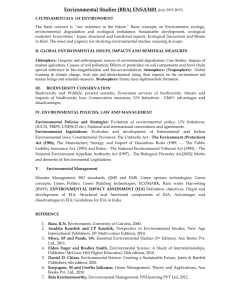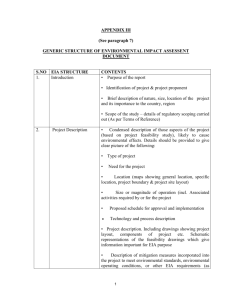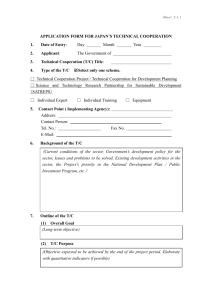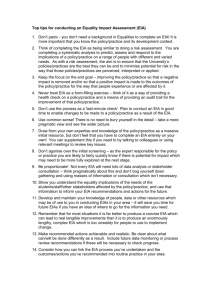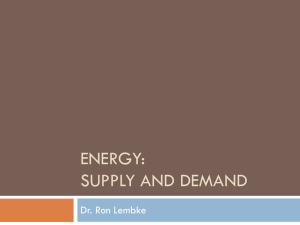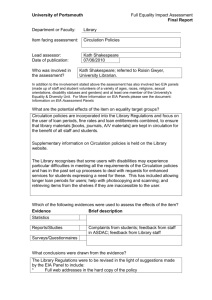eko atlantic city development project: analysis of its eia
advertisement
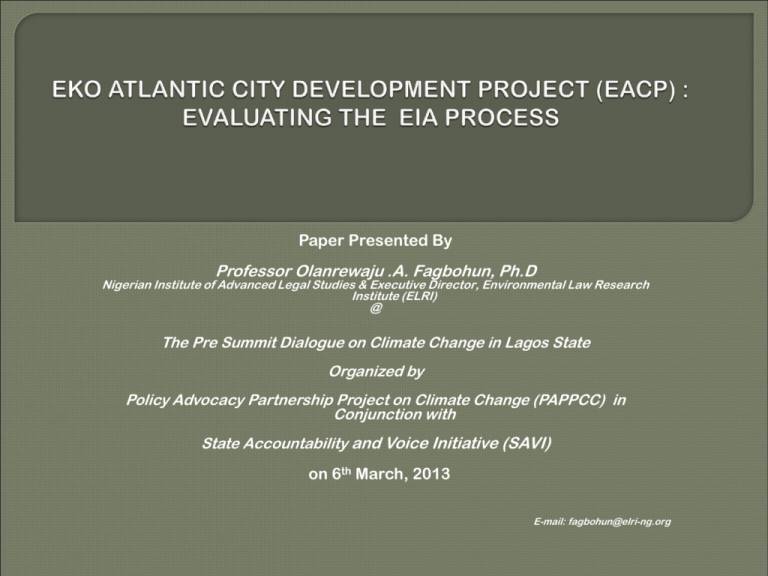
Paper Presented By Professor Olanrewaju .A. Fagbohun, Ph.D Nigerian Institute of Advanced Legal Studies & Executive Director, Environmental Law Research Institute (ELRI) @ The Pre Summit Dialogue on Climate Change in Lagos State Organized by Policy Advocacy Partnership Project on Climate Change (PAPPCC) in Conjunction with State Accountability and Voice Initiative (SAVI) on 6th March, 2013 E-mail: fagbohun@elri-ng.org Regulated by Environmental Impact Assessment Act, 1992 (Decree No. 86 of 1992) The EIA Procedural Guideline and Sectoral Guidelines Goals and Objectives: (a) to establish before a decision is taken by any person, authority, corporate body or unincorporated body, including the Government of the Federation, State or Local government intending to undertake or authorise the undertaking of any activity, those matters that may likely or to a significant extent affect the environment or have any environmental effect on those activities and which shall first be taken into account; (b) promote implementation of appropriate policy; (b) Encourage the development of procedures for information exchange, notification, and consultation… 2 Put together relevant baseline information; Provide requisite answers to the concerns and questions of stakeholders; Identify relevant socioeconomic and environmental aspects of a project; Suggest mitigation measures and re-design alternatives; Develop plans and procedures for effective proactive environmental management; Identify the legal, regulatory and policy framework, in the context of which, the EIA will be carried out for the proposed project. 3 Covers both … “public or private sector projects”. “Project” is defined as the “physical work that a proponent proposes to construct operate, modify, decommission, abandon, or otherwise carryout, or a physical activity that a proponent proposes to undertake or otherwise carry out” Extent , nature or location of a proposed project activity must be likely to significantly affect the environment 4 a) A description of the proposed activities; b) A description of the potential affected environment, including specific information necessary to identify and assess the environmental effect of the proposed activities; c) A description of the practical activities as appropriate; d) An assessment of the likely or potential environmental impacts of the proposed activity and the alternatives including the direct or indirect cumulative , short term and long-term effects; e) An identification and description of measures available to mitigate adverse environmental impacts of proposed activity and assessment of those measures; f) An indication of gaps in knowledge and uncertainty which may be encountered in computing the required information; g) An indication of whether the environment of any State or local government area or areas outside Nigeria is likely to be affected by the proposed activity or its alternatives; h) A brief and non-technical summary of the information provided under paragraphs (a) to (g) of this section. 5 EIA is not required in the case of (a) Projects with non or minimal environmental effect; (b) Projects to be carried out during national emergency for temporary measures have been taken by the Government; (c) Projects to be carried out in response to circumstances that in the opinion of the Agency, the project is in the interest of public health or safety 6 List covers: Drainage & Irrigation Airport Agricultur e Industry Forestry Housing Mining Fisheries Mandatory List Land Reclamation Infrastructur e Ports Railways Quarries Petroleum Waste Treatment & Disposal Power Generation & Transmission Transportatio n Water Supply Resort & Recreational Development 7 EIA Procedural Guideline – Steps to follow in the EIA process (Annex I of the Procedural Guideline) Sectoral Guidelines – Oil & Gas, including petroleum refining, petrochemical industry pipelines, on-shore, offshore exploration and drilling etc; – Infrastructures – including airports, construction, harbours, construction and expansion, railways, highways etc; – Industries – including all other manufacturing industries, besides those in the oil and gas sector; – Agriculture – all agricultural practices including land clearing, aforestation projects etc; – Mining – including solid minerals prospecting and exploration. 8 Category 1 – full and mandatory EIA; Category 2 – full EIA is not necessary unless the activity is within the Environmentally Sensitive Area; Category 3 – activities having beneficial impacts on the environment; Extent of EIA are thus determined either through listing or an initial environmental evaluation (IEE). 9 EACP plans to develop the shoreline of Victoria Island in Lagos State by dredging approximately 90 million cubic metres of sand from marine shelf waters to reclaim 900 hectares of land for the development of a modern city; South Energyx Nigeria Ltd (SENL) is the company created to undertake the development; Royal Haskoning completed the EIA In the EIA, SENL indicates that it was only in respect of the dredging and land reclamation activities and promises to submit a further study/report on construction over the reclaimed land. 10 A package of integrated coastal zone management to check the impacts of sea level rise resulting from global warming; Absorb an escalating population of megacity; Create employment opportunities; Protect valued land on Victoria Island from further erosion; Raising of profile of Lagos; and Reduce traffic and better public amenities. 11 Environmental alterations will occasion changes (either positive or negative in the quality of the natural system) - Impact on living aquatic and terrestrial resources; Population at risk: Maroko, Okun Alfa, Langbasa among several others. Impact on current life and livelihood patterns (socio-economic impacts) 12 EACP is classified under Category 1 as per the EIA Act, being an “infrastructure” project, and therefore considered to be environmentally sensitive. 13 Dredging commenced in EACP site in 2009; The EACP’s EIA Report was completed in April 2011, and displayed for public comments from 13th July to 12th August, 2011; The main reclaimed area is projected to be about 6km long, with a width of 1.5km on the western end, tapering to 0.5km on the eastern end; Public hearing was held on the 21st of January 2011 at Eko Hotel & Suites in Lagos; The study team consist of 25 individuals ranging from ecologist to survey specialist, social experts, engineers, air quality and noise experts, groundwater specialist, hydrobiologist and other environmental experts 14 Since dredging started long before the EIA, the project clearly failed to connect with key stakeholders (public participation) to consider the preproject concerns between environment, resources and development. This is a major flaw; − A submission after the project and not before is not in line with EIA Act. In a project of this nature, the phases will be interwoven, yet, the period of subsequent phases (aside of phase 1) are not indicated. Consequently, their uncertainties and risks are not considered; Conclusions on likely impacts of the project on adjacent coastal areas and likely snowball effect along the shoreline of the eastern Gulf of Guinea are at best conjectural and not based on solid scientific evidence from the study or existing literature; The EIA neither discussed nor reacted to the latest scientific findings and predictions from the Intergovernmental Panel on Climate Change (IPCC). This would have further helped in developing adaptation and mitigation responses; 15 SAN FRANCISCO MEXICO Built substantially on sand • filled land; Mexico City grew from an Island in the middle of Lake Texcoco; Earthquake, April 18, 1906 • ignited fire (waterpipe broke, so no water to fight the fire); Marshes were filed in the 16th century and that formed basis of modern Mexico; City burnt for 3 days; Earthquake occurred in 1985; 25,000 buildings damaged; • 250,000 people rendered homeless; economic damage estimates was over • US$350,000,000. • More than 10,000 people died (40,000); 412 buildings collapsed; another 3,124 seriously damaged; economic loss of between three and four billion US$. 16 It is never too late to engage; There is a need for a thorough and sincere review of the EACP’s EIA with key stakeholders, experts and NGOs who have been working in this area; Opinions may differ, but it is always beneficial; After all of us here present today might have gone, what will be the lot of Eko Atlantic City Project? 17 Thank you all for listening Acknowledgement: Special thanks to my colleague, Ako Amadi, CEO of CCDI for allowing me the use of some of his materials 18

